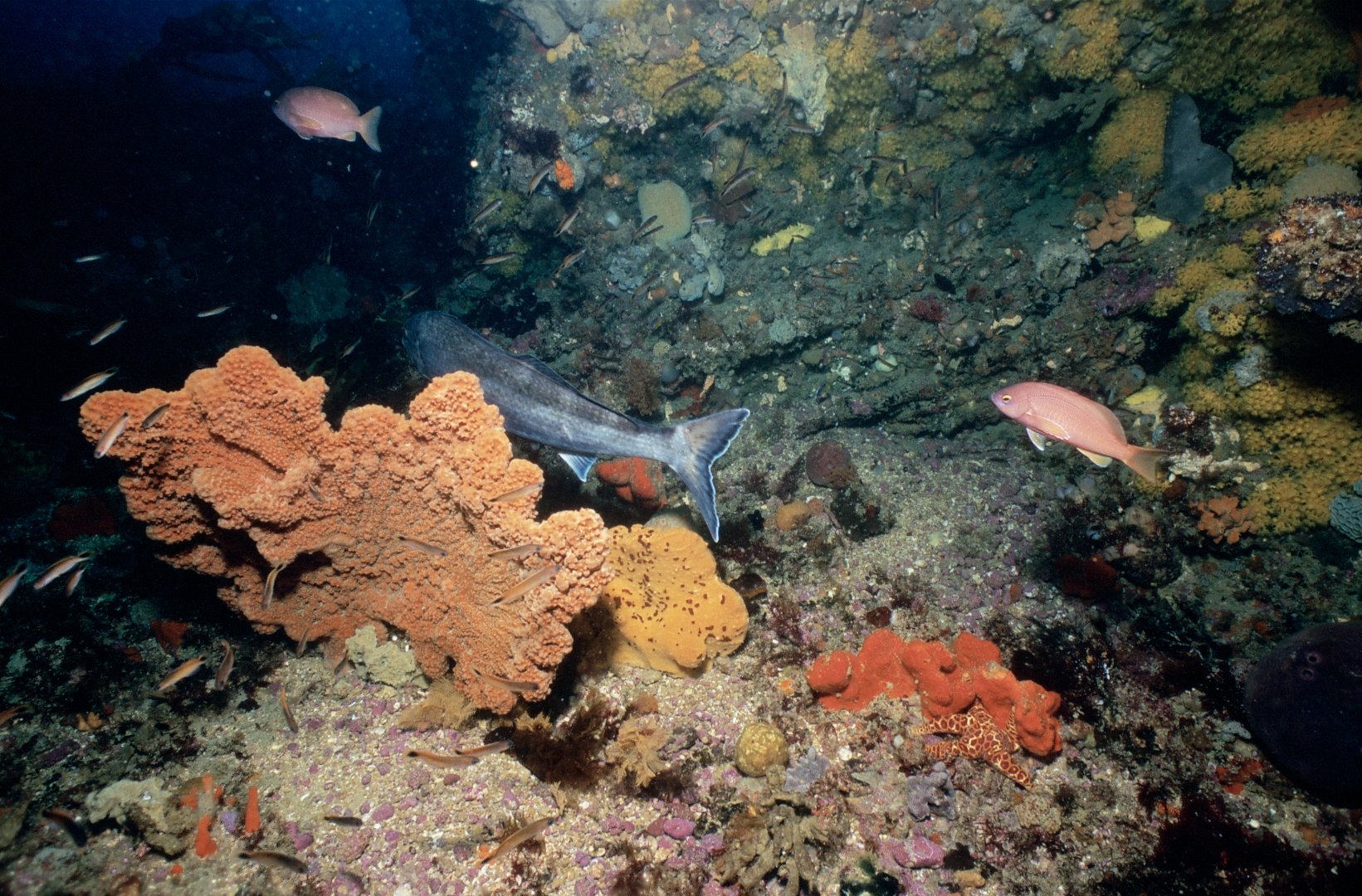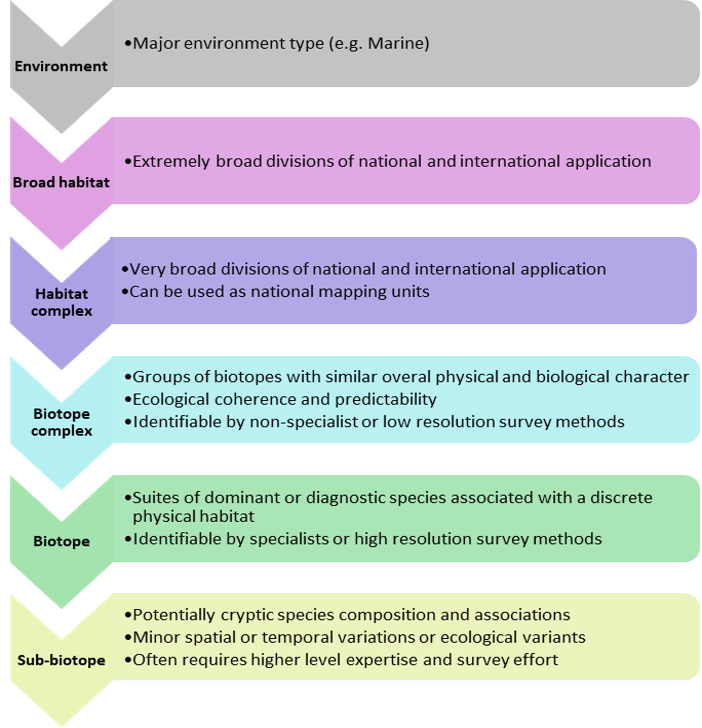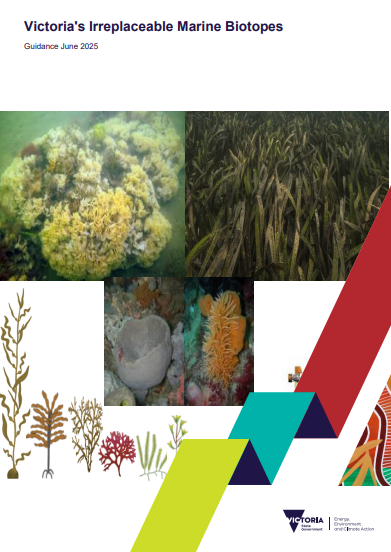Irreplaceable marine biotopes are difficult to successfully restore or create because methods of restoration are difficult or unknown, they are very slow to recover, they may be rare based on their extent, range or distribution. They might also exist in rare, unusual or distinct environmental contexts.
The identification and classification of irreplaceable marine biotopes can guide decisions about the sensitivity, risk and consequences of potential activities, disturbances and pressures in these locations.
Victoria's Irreplaceable Marine Biotopes are being added to CoastKit. To be notified when they are available join our CoastKit News email list!

What is a marine biotope?
A marine biotope represents a distinct ecological niche where marine organisms thrive. This refers to a specific habitat in the marine environment, including the physical conditions and the associated species community. It’s defined based on geographical location, physiographic features, and the physical and chemical environment. These factors include salinity, wave exposure, tidal strength, geology, biological zones, substratum type (such as rock, sand, or mud), and specific features like crevices or overhangs.
In Victoria, biotopes are classified in a hierarchical catalogue termed the Combined Biotope Classification Scheme (PDF, 5.5 MB) (CBiCS). The biotic component is the central classification component of CBICS, comprising six hierarchical levels. The design of this hierarchy and concatenated coding system is adopted directly from the Joint Nature Conservation Council (JNCC) and the European Nature Information System (EUNIS) schema.
Biotopes and their constituent species provide a basis for understanding representativeness of marine biodiversity and are now used as the international standard for attributing biodiversity significance, irreplaceability, and the spatial unit to attribute the United Nations System of Environmental Economic Accounting for ecosystem accounting for the ocean.

What makes a biotope irreplaceable?
Irreplaceable marine biotopes (habitats) are those which cannot be successfully restored or created, based on one or more of the following factors:
- Difficulty of Restoration: Irreplaceable biotopes are either very difficult to restore or very slow to recover, where:
- “Very slow” recovery typically exceeds 25 years.
- “Not feasible” refers to in-situ restoration that has:
- unproven scalability
- no known effective methods, or historically unsuccessful
- environmental constraints that render current methods as unfeasible
- Rarity’ and ‘Uniqueness of the Environment’ which pose challenges and risk for achieving successful restoration. Biotopes can be restricted or rare, based on their known areas of occupancy and distribution. Additionally, certain biotopes may only persist in an environmental setting where the physical substratum, geoform and hydrodynamics of their environment is unique or limited in distribution.
Why identify irreplaceable biotopes?
The identification and classification of irreplaceable marine biotopes serve to guide decisions regarding the sensitivity, risk, and consequences associated with disturbances by anthropogenic activities and pressures. By pinpointing these irreplaceable biotopes, planners and developers can avoid actions that would result in irreversible damage given challenges in recreating them elsewhere.
Additionally, this classification aims to inspire scientists to develop technically feasible restoration methods for certain biotopes currently considered irreplaceable. Developing effective and scalable restoration techniques in the marine environment is recognised as difficult. Many methods that work on a small scale may not be feasible or effective on a larger scale. Irreplaceable biotopes that have evolved in a distinctive environmental setting that is not replicated elsewhere would be challenging to restore as it is cost prohibitive and unfeasible to recreate that environmental setting in another location.
What about Key Ecological Features (KEF)?
Marine biotopes can also be designated as KEFs if they are recognised as important for biodiversity or provide an important ecosystem function. For example, a marine biotope may be the critical habitat for the persistence of a threatened species, or it may serve as nursery habitat for a commercial fish species. KEFs may relate to a species (e.g. a predator that impacts a large biomass or number of species), an important habitat type (e.g. supports high productivity or aggregations of breeding animals), or a unique seafloor or oceanographic feature that positively influences the surrounding ecosystem (e.g. a deep canyon that stimulates upwellings of nutrient rich water).
Victoria’s marine KEFs will be described in a separate project using scientific criteria for identifying Ecologically or Biologically Significant Marine Areas.
Irreplaceability Criteria
Marine biotopes can be attributed based on their life history context with irreplaceability criteria. Each criterion is scored with a set of standardised criteria with ordinal rank definitions for natural recovery potential (years to recover); restoration potential and feasibility; rarity (based on number of records, regional and global distribution); and the uniqueness of the environmental context (physical and hydrodynamic).
Each biotope was assessed against the criteria and assigned as ‘Irreplaceable’ if scored highly in either ‘Recovery’ (4 and above) and ‘Restoration potential and feasibility’ (3 and above); and assigned as ‘Restricted or Rare’ if scored highly in any of the ‘Rarity’ (4 and above) and ‘Uniqueness of the Environment’ (3) criteria.
Statutory Protection
Statutory protection status was incorporated into the final score. Although not used as a criterion for determining irreplaceability, it is an important consideration for managers, planners and developers. Statutory protection status pertains to a biotope, or a species that is characteristic of a biotope, that is listed under the Flora and Fauna Guarantee Act 1988 (FFG Act), or the Environment Protection and Biodiversity Conservation Act 1999 (EPBC Act), or known to occur in a protected area under the National Parks Act 1975.
The status of statutory protection of biotopes is based on best available information. It should be used cautiously and is intended as a guideline. A biotope is considered protected if it is located within a marine protected area (MPA) or is part of a listed threatened community, based on available historical surveys. However, this does not guarantee protection in all locations where the biotope occurs. Conversely, a biotope may not be recognized as protected even if it is within an MPA, if this information was not available during the assessment. Statutory listing information can change, so always use the most current data for the FFG and EPBC Acts, and within MPA boundaries. MPAs include Marine National Parks and Marine Sanctuaries, which are highly protected "no-take" areas, while Marine and Coastal Parks, Marine Parks, and Marine Reserves are managed for multiple uses.
Which biotopes are irreplaceable?
In general, biotopes that are found in the CBICS Level 3 Habitat Complex, defined by substratum, depth, and energy, that typically exhibit many irreplaceable at CBICS Level 4 to 6 biotopes include:
- Moderate and low energy supralittoral rock biotopes (e.g. characterised with rare lichen communities)
- High and moderate energy infralittoral rock biotopes (e.g. characterised with species of Macrocystis and Amphibolis)
- Tide swept channels of circalittoral rock biotopes (e.g. biotopes associated with Port Phillip Bay Entrance Canyon, Crawfish Rock and Corinella Circalittoral Reef)
- Sublittoral rhodolith bed biotopes. Rhodoliths are agglomerations of coralline algae forming nodules of various morphological types. Rhodolith beds create biogenic habitat that enhances biodiversity compared to surrounding sediment beds and are major producers and sinks of calcium carbonate. Rhodolith beds can occupy vast areas around the world and in Australia. They are likely to play an important role in carbon cycles, carbon sinks into sediments and are susceptible to ocean acidification.
- Sublittoral sediment seagrass biotopes. Presently, there is no evidence that Heterozostera / Zostera spp. seagrass beds in Victoria can be restored at scale, although research efforts to redress this are in progress. Posidonia australis recovers very slowly from disturbance. It is long-lived, slow growing species only found in the marine waters of Corner Inlet and Nooramunga in Gippsland. Historic projects that have attempted to restore this seagrass species have been unsuccessful.
Which are not considered irreplaceable?
Biotopes that are not considered irreplaceable include many intertidal sedimentary habitats that recover quickly from disturbances, are widespread, and are characterized by common species. Subtidal sedimentary biotopes are similar but are not as easy to restore and/or may take a longer period to recover. Whilst saltmarsh and mangrove biotopes have slow recovery rates, they are the most feasible marine biotopes to restore with high success rates reported globally.
Irreplaceability categories
One of four irreplaceability categories, with a corresponding sub-category, were assigned to each biotope complex, biotope or sub-biotope in the CBICS catalogue by combining the irreplaceability criteria scoring and relevant statutory protection association.
Category 1: Irreplaceable - Statutory Protected
1A Rare or restricted distribution
- High energy Macrocystis overstorey communities (ba3.15), which meet criteria for the EPBC listed community: Giant Kelp Marine Forests of Southeast Australia Ecological Community (Macrocystis pyrifera).
- Deep jewel anemone communities (ba4.27), which comprises communities within the FFG listed community: Port Phillip Bay Entrance Deep Canyon Marine Community.
- Crawfish Rock (ba4.2b2) with FFG listed Ralpharia coccinea (stalked hydroid).
1B Not rare
- Heterozostera nigricaulis bed (ba5.831), FFG listed seagrass.
- Heterozostera tasmanica (ba5.836), FFG listed seagrass.
- Ecklonia with subcomponents of Phyllospora, Seiroccoccus and Acrocarpia (ba3.1434), Ecklonia radiata with bushy bryozoans, Seirococcus axillaris and thallose red algae biotope. Occurs in deep, high-energy waters attached to steep rock surfaces, represented within Wilsons Promontory Marine National Park.
Category 2: Irreplaceable - Not Statutory Protected
2A Rare or restricted distribution
- High to moderate energy tide-swept Ecklonia-Phyllospora communities (ba3.1c), occurs in high energy infralittoral rock facies, located in a small number of tidal channels.
- Thallose red algae with abundant Cenolia trichoptera feather stars (Ninety Mile Beach A) (ba3.19d1). Only known from high energy infralittoral rock and sandy veneer facies within the 90 Mile Beach biounit.
2B Not rare
- Foliose red seaweeds on upper infralittoral rock - high energy (ba3.18). These biotopes are found in several locations of Victoria; however, any restoration efforts would be environmentally constrained.
Category 3: Not deemed Irreplaceable - Statutory Protected
3A Rare or restricted distribution
- Several biotopes of coastal saltmarsh aggregate and estuarine wetland ecological vegetation communities in Victoria defined as EPBC listed community: Subtropical and Temperate Coastal Saltmarsh.
3B Not rare
- Aviccenia Mangrove Shrubland (EVC140) (bab.11), includes FFG listed Avicennia marina subsp. Australasica and can be found in French Island Marine National Park among other locations.
Category 4: Not deemed Irreplaceable - Not Statutory Protected
4A Rare or restricted distribution
- Seasonally Inundated Sub-saline Herbland (EVC 196) (baa.e1) and Brackish Grassland (EVC 934) (baa.f1.)
4B Not rare
- Numerous littoral rock and sediment biotopes of intertidal rocky shores and sandy dunes respectively. Biotopes historically modified and heavily impacted by anthropogenic activities (e.g. dredge material grounds) or invasive species (e.g. Spartina spp. stands).
Page last updated: 08/07/25
